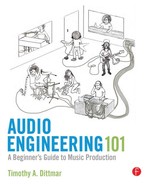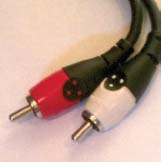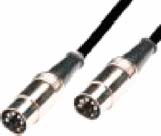AUDIO CONNECTORS
A variety of connectors are used in music production. It will be helpful if you can recognize the differences and uses of each connector. A jack is used to describe the female side of an audio connector, whereas a plug is used to describe the male side of a connector. A plug is inserted into a jack. As mentioned in Appendix A, some connectors are associated with balanced lines/signals, whereas others are associated with unbalanced lines/signals. In addition, some connectors can be used for both analog and digital purposes. Let's start with analog connectors.
Analog Connectors
Four common connectors associated with analog equipment are as follows:
1. PHONE (aka 1/4”, T/S, or T/R/S): Originally adopted by Ma Bell for use with phone operator switchboards. Commonly used with instruments (guitar, keyboards, and bass) and patchbays. Comes in both T/S (tip/sleeve) and T/R/S (tip/ring/sleeve). A T/S will have a single band around the tip of the connector, whereas a T/R/S will have two bands around the tip.
Figure B.1
Audio Engineering 101. DOI: 10.1016/B978-0-240-81915-0.00016-3
© 2012 Timothy A. Dittmar. Published by Elsevier Inc. All rights reserved.
2. XLR (aka Cannon, Mic, or Neutrik): Typically a three-pin connection but is available in other pin configurations. Provides a very secure connection. These connectors are usually associated with mic cables and balanced audio. The male end of the connector is most often used for input, whereas the female end of the connector is used for output.
Figure B.2
3. MINI (aka 1/8”, 3.5mm): Smaller version of the 1/4”. Comes in both T/S and T/R/S. Associated with personal stereo headphones, iPods, and computer sound cards.
Figure B.3
4. RCA (aka phono): Usually comes in mono pairs and is used in conjunction with consumer audio/stereo setups. Record players generally have RCA outputs. The tip caries the signal and the ring is the ground. This is an unbalanced connector.
Figure B.4
 TIP
TIP
It is extremely crucial to maintain the integrity of digital audio. Digital signals use many of the same type connectors as analog; however, they are usually higher quality and gold tipped. A S/PDIF can use unbalanced RCA phono type connectors, whereas AES/EBU can use three-pin XLR balanced connectors.
A few other connectors associated with analog equipment are as follows:
Tuchel: Come in various pin configurations. They have an outer locking ring and are well known throughout Europe. Smaller tuchel connectors are common with some vintage mics, whereas larger tuchel connectors may be found on some older model recording consoles and high-fidelity audio equipment.
Figure B.5
ELCO/Edac: Multipin connector used in conjunction with tape machines, consoles, and sound reinforcement. Banana plug: Used to connect higher end audio amplifiers and speakers.
Figure B.6
Figure B.7
Speakon: Designed as a tight fitting speaker connector. Excellent choice with live sound reinforcement.
Figure B.8
Digital Audio Connectors
AES/EBU: Created by the Audio Engineering Society and European Broadcast Union to develop a standard when digitizing analog audio. The connector looks like a typical XLR and is often used with a digital work clock and/or I/Os. Other connectors may be used for AES/EBU protocol such as a DB25.
Figure B.9
S/PDIF (Sony/Phillips Digital Interconnect Format): An audio protocol associated with digital consumer audio gear. Used to interconnect components over shorter distances. The connector looks like a common RCA connector but can also be found as a TOSLINK connector.
Figure B.10
TDIF (TASCAM Digital Interconnect Format): It is a proprietary connector used by TASCAM. TDIF uses a bidirectional connection. Unlike the ADAT light pipe connection, it can both send and receive up to eight channels of information with a single cable.
Figure B.11
ADAT Lightpipe: Developed by Alesis to carry up to eight channels of uncompressed audio at 24 bit and 48 kHz using fiber optic cables.
Figure B.12
Optical/TOSLINK: Usually associated with an optical connection. Newer equipment often uses a TOSLINK, replacing the coaxial S/PDIF connector.
Figure B.13
MADI (Multi Audio Digital Interface): Another audio protocol besides S/PDIF and AES/EBU used to transmit digital audio. MADI supports a greater number of channels. AMS Neve, Soundcraft, Lynx, Avid Technology, and many other audio companies use MADI protocol. Typically uses an optical connector. USB (Universal Serial Bus): Designed for communication and as a power supply for computers and other electronic devices. Can be identified by its trident logo. New versions have been made available that significantly increase the speed at which data is transferred. The connector comes in several versions. Pictured here are the common Type A and Type B. USB Flash drives are often used to backup and store important files.
Figure B.14
Fire wire (Apple's high-speed serial bus design): Often used to transfer data to external hard drives, webcams, and Apple's own iPod. Firewire is capable of transferring audio and video at about the same speed as USB 2.0.
Figure B.15
DIN MIDI connector: A five-pin round connector used for MIDI protocol. Preceded USB and Firewire. Used to interface synthesizers, lights, and other various controllers.
Figure B.16
DB25: A 25-multipin connector. Used with analog or digital audio signals. Often used with analog for an eight-channel snake or other multichannel audio configuration. With digital audio, DB25 is commonly used for AES/EBU multichannel signal. DB25 connectors are great for a tidy and secure connection. However, the pins are easily bent and they are very difficult to repair and build.
Figure B.17
A few links to purchase audio connectors, cables, and parts are the following:
















